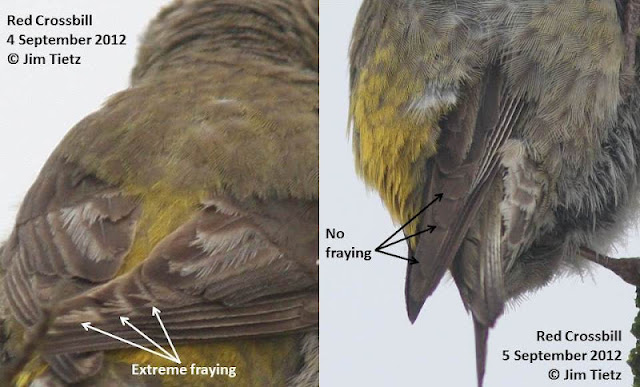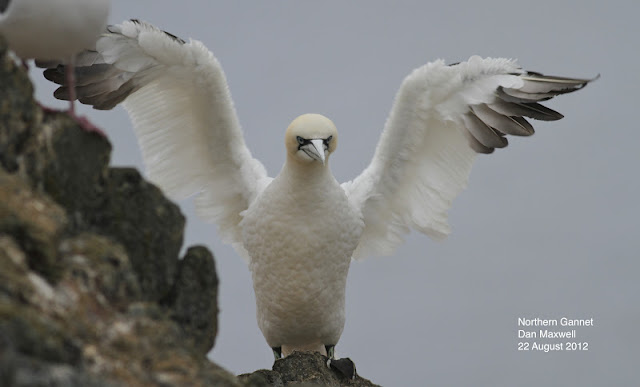The 16th through the 18th brought low winds and high overcast skies, which meant that good numbers of migrant birds descended upon the island. On the 16th we banded our first Yellow-rumped Warbler of the fall as well as our second Baltimore Oriole of the season; interestingly we have yet to record a Bullock's Oriole for the fall, which is normally our most common oriole. In addition, we had 11 species of warbler including a Black-and-white Warbler, 2 Chestnut-sided Warblers, a new Magnolia Warbler, and 3 Blackpoll Warblers. We also spotted a Vaux's Swift zipping past the lighthouse.
 | ||
On the Farallones, we color-band six songbird species, including this Townsend's Warbler. Each individual bird gets a unique color combination, which allows us to identify individual birds in the field without recapturing them, so that we can keep track of how many birds of our most common species are on the island each day.
The 17th brought us more migrants including a mixed flock of six teal, 3 Blue-winged Teal and 3 Cinnamon Teal. The Cinnamon were the first in over a decade, while the Blue-wings represented the 11th, 12th, and 13th records for the island and an island high count. Immatures and females of these two species are very similar in appearance, but lucky for us, they circled close to the island a few times, and we were able to get some good photos to aid in identifying them. The primary features to distinguish them are bill size (longer and spatulate in Cinnamon) and facial plumage (distinct white wrapping around the underside of the bill in Blue-winged). Can you figure out which are which? The day continued with the first Vesper Sparrow of the Fall, a male Indigo Bunting, a male Dickcissel, and a Bobolink. We also added to the warbler count with 2 MacGillivray's Warblers, a Wilson's Warbler, and a Tennessee Warbler.
The 18th continued to be calm and cloudy and added several new migrants to the many birds still refueling from the previous two days. Notable arrivals for the day included a Willow Flycatcher, a Hammond's Flycatcher, the first Hermit Thrushes of the fall, a Painted Bunting, and 3 more species of Warbler including Blackburnian Warbler and Bay-Breasted Warbler - all and all a pretty nice little wave. We ended up seeing 17 species of Warbler over the 3-day wave. Although the last few days have been windy, with thick fog the past two days, we're hopeful that conditions will improve in the near future so we can catch another wave.
In addition to studying the flying migrants, we conduct daily surveys from the lighthouse to document the occurrence of white sharks around the island as they fuel up each fall for their annual migration to the middle of the Pacific, where breeding is thought to occur. The Farallones is the only places in California where white shark attacks can be routinely viewed. A recent analysis of shark genetics and transmitter data has revealed that the population in the northeastern Pacific (the ones we see in California) is genetically and geographically isolated from the other populations around the world (Jorgensen et al., 2009, Proc. Roy. Soc). Furthermore, using underwater videography to identify individuals has led researchers to believe that this population is extremely low, possibly less than 400 adults (Chapple et al., 2011, Mar. Bio.). For this reason, there is a push amongst conservation groups to get this population listed as federally threatened or endangered. Over the past several years, the numbers of attacks at the Farallones has been steadily declining, so the seven attacks we have witnessed thus far during September have been a welcomed turn of events.
|
While looking for sharks, we also document the number of cetaceans within sight. For the first two weeks of September, we were seeing three resident Gray Whales that spend their time foraging around the island, but lately a fourth may have joined the group. After spending hours watching them cruise around during shark watch, we have become pretty familiar with each individual and have given them names so we can discuss which ones we are seeing. The two in this photo are affectionately known as Big Moby (in the back) and Lil' Moby (in the front). The third resident, Big Spot, is one that we have been seeing for at least the past three years. The fourth individual is also small and has quite a bit of red on its forehead. Its name is less settled, but has been referred to as Red Face or Lil' Red. |
Tune in next week for more excitement.










































